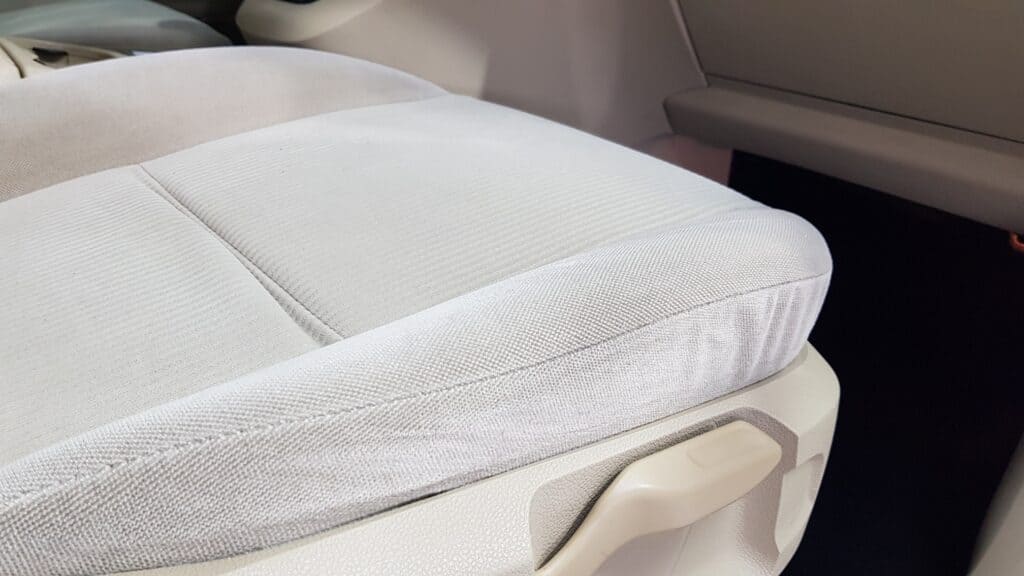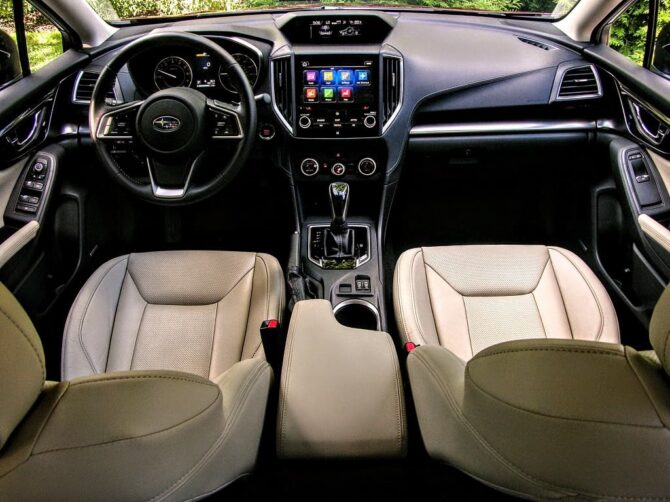While sipping a cup of coffee on the way to work is a popular way of starting the day, there are other, far more effective methods of waking up. Ever try spilling a scalding hot beverage all over your groin while navigating through rush hour traffic? Talk about being alert!
This adrenaline-filled experience is often accompanied by a few “choice metaphors,” followed by a quick pit-stop at the nearest service station, where you will likely be greeted by a ghastly sight. Not only has your crotch been thoroughly coated in rich Arabica roastiness, but your vehicle’s seat cushion, as well as a hefty portion of the carpeted floor mat underneath it has been drenched in drip coffee.
A far more colorful string of “metaphors” later, and you find yourself on your smartphone, desperately searching for the fastest and most effective way of removing this plant-based beverage from your vehicle’s upholstery.
Cleaning-up spilled coffee can be a bit tricky, especially on lighter colored fabrics. Fortunately, there are a few ways to make coffee stain removal far less time consuming and labor intensive.
Today, we’ll explore some of these methods, along with a few chemicals and alternative products for removing coffee stains. It’s not like you can throw your driver’s seat in the wash along with your Sumatran soiled trousers, so you might as well study-up and stock-up on some scrubbing essentials, because you never know when coffee might strike again…

The Science Behind Coffee’s Ability to Stain
People assume that the darker the roast, the tougher the stain, but there’s way more to a coffee spill than just a pool of opaque bitterness.
Like grapes, tea, and many other consumable plant-based foods, coffee contains tannins. This naturally occurring chemical helps give coffee its distinct flavor and astringent bitterness, as well as the stain on your car seat its staying power.
While not all plants have tannins, those that do pack these biomolecules, use them as an unappetizing means of dissuading animals from eating their stain-inducing berries, fruit, leaves, bark, and various other parts.
But leave it to us humans to develop a taste for the unpalatable…
Thus far we’ve developed an affinity for many of the world’s hottest peppers, found ways to safely consume all manner of rotten and fermented food, and even devised a method for safely cleaning and eating poisonous blowfish. So when it came to making coffee consumable, all we had to do was dry and roast the beans, grind them up, and throw some hot water into the mix.
So, what’s a tiny tannin stain got that us humanoids can’t handle? You’d be surprised…

Photo Credit: 102.3 Now!/Radio Facebook
Why Coffee Stains On a Car Seat Suck
While the tannins in coffee beans may help it deter the hungry advances of many of the world’s animals and insects, it also has the ability to form a fairly tough stain when allowed to dry.
Further compounding the matter, is the fact that the hot nature of the liquid (assuming that you aren’t sipping an iced latte) tends to evaporate at an alarming rate, thus making the stain removal process all the more pressing.
The reason for the rush is simple. As the the outside of the soaked area dries, the liquid toward the center of the stain starts to spread outward, bringing with it all of those tannins we just discussed. The result: A ring of brown, tannin-rich coffee that is quite unsightly.
“Almost half (48%) of daily coffee drinkers who buy their coffee at a quick service restaurant, cafe, donut shop or convenience store do so through a drive-through.“
–National Coffee Association of U.S.A., Inc. “Atlas of American Coffee”
Quick Nerd Note: Ever notice that the insides of the acrylic coffee dispensers down at the local supermarket appear super greasy? That’s because coffee beans contain oil. LOTS of oil. Add-in the fact that many humans like to add sticky sweeteners and fatty dairy products to their java, and you’ve got the perfect blend for some super stubborn seat and upholstery stains.

How to Remove Fresh Coffee Spills
So now that you understand what causes a coffee stain to form, it’s time to discuss ways of keeping coffee spills under control.
The first thing to remember is that you have to act fast. Neutralizing the spill before it becomes a stain means preventing the coffee from drying, at which point it becomes a massive pain in the ass to remove.
Here are the steps you’ll need to quarantine, and then neutralize fresh coffee spills, all of which have been proven to work with both hot and cold coffee.

Step 1 – Pull Over ASAP
If you spill coffee while driving, the first thing you should do is find a safe place to pull over, in order to assess the damage, and perhaps purchase a fresh pair of pants.
DO NOT attempt to determine the severity of the spill or soak-up the coffee while driving. The average coffee spill clean-up process is both labor intensive and two-handed, so unless you’ve just grown an extra set of arms, don’t assume that you can clean-up and drive at the same time.

Step 2 – Soak Up Any Excess Liquid
Once outside of your automobile, try to ascertain as to whether there is still standing liquid on the seat, floor, or upholstery.
Saturated areas detected, use a clean microfiber cloth to soak-up any pools by blotting the surface in a gentle pressing motion.
Repeat this step until the microfiber cloth is completely saturated, swapping in a fresh towel as necessary. No one knows when one of life’s little surprises is going to require emergency countermeasures, which is precisely why we sell our ultra-absorbent microfiber cloths in a six-pack.
Quick Tip: Try to avoid rubbing a freshly spilled coffee stain, for it may cause those pesky tannins to further embed themselves into the surface. This warning rings especially true for those who have cloth seats, where liquids are far more prone to penetrating the fabric and the foam cushioning underneath.

Step 3 – Snag Some Supplies
If you are fortunate enough to have pulled over at a gas stand or service station, chances are the following supplies will be inside. If not, seek-out a hardware or auto parts store, because the sooner you can put the following items into action the better.
- (1) Soft bristle brush
- (1) Can of upholstery cleaner
- (1) Spray bottle filled with clean water
- Additional microfiber cloths (as needed)

Photo Credit: Wolfsteins Pro-Series/YouTube
Step 4 – Remove Coffee Grounds
The level of oils and tannins found within coffee grounds is significantly higher than that of the liquid itself. Therefore, preventing coffee grounds from sitting on a surface for too long will help reduce the intensity of the stain it leaves behind.
The use of a soft bristled brush and a vacuum will do wonders in this sort of situation, so have both at the ready if you feel like there may be coffee “sludge” on your car seat or carpet. In most cases, you will find that the average “pay-to-suck” vacuum at a gas station to be more than sufficient.

Photo Credit: Micah Wright
Step 5 – Apply Carpet and Upholstery Cleaner
Coffee grounds and residue removed, spray a layer of carpet and upholstery cleaner onto the coffee spill, carefully heeding the instructions on the label at all times. Also, note that some products are not deemed safe to use on leather or vinyl surfaces, so be sure to read the application requirements prior to applying these chemicals.

Step 6 – Apply Water and Blot Dry
Applying water to a coffee stain is highly debated in the automotive detailing world. While some people claim that hot water works best in this sort of scenario, many find that the cold-water approach tends to be the easiest (and safest) application method.
While pouring a splash of H2O out of a bottle of spring water may work in a pinch, the risk of oversaturating the surface remains quite high. A spray bottle approach is far safer, as it allows you to “mist” the surface until it is deemed wet enough to blot dry.

How to Remove Dry Coffee Stains on Cloth Car Seats
While the method above works great at preventing a coffee spill from drying, quickly nipping the issue in the “bean” isn’t always an option. If spilled coffee is allowed to dry on a cloth seat or fabric upholstery, one (or all) of the following techniques and supplies must be put into action.

Method #1 – Vinegar and Water
Vinegar. It’s not just for making pickles anymore.
Vinegar truly is some amazing stuff. Not only does this acidic substance do a fantastic job of removing odors, but it also kicks ass at breaking down plant-based substances, like coffee stains for instance.
The following concoction consists of a splash of distilled white vinegar, some fresh water, and a dash of basic car cleaning chemicals. Once blended, this mixture can do wonders for coffee soaked cloth car seats and upholstery fabric. Here’s how you make the magic happen…
- Mix 1 part vinegar with 16 parts water in a spray bottle
- Add a few drops of quality car shampoo to the vinegar/water solution for further deep cleaning and enhanced aromatics
Spray the vinegar solution on the stained area, allowing it to soak-in for a minute or two, before working it into the fabric with an upholstery brush. Stain scrubbed, allow the solution to sit for about 20 minutes, before applying fresh water to the area, and then blotting it dry with a clean microfiber cloth.
“Around 125 million people worldwide depend on coffee for their livelihoods. It is one of the most valuable and widely traded tropical agricultural products and is mainly produced by smallholder farmers.”
–Fairtrade Foundation

Method #2 – Glass Cleaner
Another solution for removing coffee stains is glass cleaner. For this to work correctly, you’ll simply need some standard, ammonia-rich glass cleaner, some water, and a dry microfiber cloth.
But before you go wild, and spray your entire interior, be sure to test the glass cleaner on a small, inconspicuous area to ensure that it doesn’t cause further damage. If you don’t detect any discoloration issues after a minute or two, proceed with spraying the glass cleaner on the dried coffee stain until it’s thoroughly saturated.
Allow the glass cleaner to do its work for about five minutes, then blot the stained area dry with a fresh microfiber towel. Repeat as necessary until the stain has been lifted, then spray the area with clean water and blot dry one last time.

Method #3 – Sprinkle Some Baking Soda
If the aforementioned methods fail to remove your hardened coffee stain, your best bet is to break out the big guns, and take the baking soda approach.
Once mixed with a splash of water, baking soda turns into this concentrated, paste-like substance that simultaneously lifts stains and removes odors. Applying this stuff to clean coffee stains is super straightforward, if all but a wee bit messy.
- Spray coffee stain with water until damp to the touch.
- Blend baking soda with fresh water until a grainy, paste-like lather is formed.
- Using a light brush, gently rub the baking soda paste into the stain.
- Allow the paste to sit on the surface for about 10-20 minutes before wiping away a corner of the stain with a wet microfiber cloth for a quick inspection.
- If the stain seems to have dissipated, use a fresh microfiber cloth with cool water to remove the rest of the baking soda solution.
- Vacuum-up any baking soda residue that still may be lounging around before calling it quits.

How to Remove Coffee Stains on Leather and Vinyl Car Interior Surfaces
While the home remedies listed above are good for removing coffee stains from cloth upholstery, they may not cut the kimchi if you have soiled leather or vinyl surfaces.
For these sorts of situations, you will need to use a leather-specific scrubbing agent, or a vinyl-friendly cleaner. Many of these material-specific chemicals are pH balanced to not discolor or damage upholstery, and often come in foaming form to better penetrate the perforated holes found in vinyl and leather interior surfaces.
Paired with a leather and vinyl approved soft bristle brush, and then followed by a gentle microfiber towel wipe-down, those pesky coffee stains will quickly become little more than a bad memory.

Photo Credit: Micah Wright
Parting Shots
Regardless as to whether you prefer scalding hot cups of jet-black java, or frothy sips of ice-cold cocoa mocha macchiato, you should remain mindful of that caffeinated concoction in your hand.
While this bean-derived beverage may boost energy levels and make your concentration far more acute, it will also do one hell of a number on your vehicle’s interior.
Safely and successfully completing your morning commute means driving with care, and that extends to your consumption of coffee as well.
So sip responsibly, and clean-up those coffee spills immediately after they happen, utilizing the above options as necessary. Remember, if the coffee spill is allowed to dry, the stain’s removal will become far more labor and chemical intensive, so don’t procrastinate!
If you are still unsure as to what to do in the case of a caffeine catastrophe, reach out to your local automotive detailer, and they will be more than happy to offer some advise. As for all other, nano ceramic coating needs, as well as microfiber towel and car shampoo questions, hit-up the AvalonKing hotline for answers to all of your burning car detailing questions.












